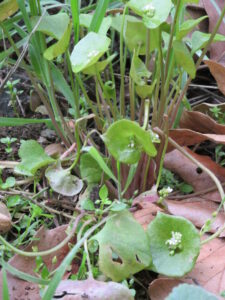Is it possible in the city? Billy Nickel’s 7 day experiment
By Christopher Nyerges
[Books and Classes by Christopher Nyerges can be viewed at www.SchoolofSelf-Reliance.com]
Billy Nickel, 53, is a professional electrician who has also spent hundreds of hours in the last 15 years studying ethnobotany, and related survival skills.
In the early spring of 2010, he was between jobs and living in the Hollywood area. He was also trying to lose weight at the time and improve his lifestyle, and he embarked on a seven-day experiment. “Could I live off the land using just the wild foods I find?” he asked himself.
So, each day, he walked approximately one mile to Griffith Park to his north. Griffith Park is located not far from downtown Los Angeles, and is considered the largest urban park in the United States.
He decided to do a seven day experiment, as a test of his self-reliance, and secondly, as a way to lose weight. “I had been doing a lot of hiking then,” he explained, “and so I walked from my house to Griffith Park about a mile away. I did that walk every day during the seven day experiment.”
He started his experiment on a Monday, and walked to the park with a large bag, and a large salad bowl.
He carried the large bag for collecting the greens, and a large salad bowl, which measured about 14 inches across and 8 inches deep. “I used the bag to collect the greens, and then I washed them in the park at the water spigot. I tore them up into little pieces, and used a cutting board and chopped up all the greens. Then I sat there in the park, and ate a big salad every day,” says Nickel.
What exactly did he eat? “I found lambs quarters, which was the main plant I ate.” Lambs quarter (Chenopodium album), is a relative of spinach and quinoa. “I ate a lot of London rocket (Sisymbrium irio), and the flower heads of various mustards. I didn’t care for the black mustard leaves because they were a bit furry. I ate some pineappleweed flower heads too,” he explained. Pineapple weed is a close relative of chamomille which grows wild.
Lambs quarter (Chenopodium album), one of the plants that Nickel ate during his 7 day experiment.
During his seven-day experiment, he found some sow thistle greens (Sonchus sp.), some mallow (Malva neglecta), some curly dock greens (Rumex crispus), and what he calls “a hidden patch of nasturtium” whose leaves he picked and included in his salads. “I also know of a little stream in the park where there is a field of miner’s lettuce and chickweed, which I included in my salads.”
London rocket (Sisymbrium irio), a member of the Mustard Family who leaves can be eaten raw or cooked. This was one of the plants that Nickel ate during his experiment.
Nickel nearly always processed the greens each day and ate it in the park. He seasoned the salad with olive oil and vinaigrette dressing that he carried along, but otherwise it was a 100% foraged salad.
So each day, all that Nickel ate was this huge raw salad, with dressing and olive oil.
Nickel ate some chickweed (Stellaria media) during his wild food experiment.
He always felt full and he didn’t eat anything else in the early part of the day or later in the day. “I never really felt like eating beyond that,” explains Nickel, “but it actually took me at least half an hour to eat the salad! I had to chew everything really well!”
Miners Lettuce (Claytonia perfoliate) is a tasty green, raw or cooked. Nickel included some of this plant in his daily salads.
Towards the end of the seven days, Nickel still enjoyed each salad and found it very satisfying, but “I could tell my body was craving protein. I started getting the urge to get a burger. But I never felt weak or a loss of energy from the all raw, all wild diet of salads. I just started to have the overwhelming desire to have a burger. I had only planned to do this for a week, and maybe that’s all I could handle because I was fixated on getting meat towards the end.” Nickel shared that he had not yet realized the value of seeds and grains in a diet of foraged food, which would have helped to provide a more balanced diet with more calories.
“The thing I noted most,” explains Nickel, “was that it was quite an ordeal to eat! Each day’s walk to the park, foraging, cleaning, processing and eating, and then walking home took at least 6 hours. Once it took nearly 8 hours. I was between jobs then so I had the time, but I hadn’t realized that the entire food quest was such a time-consuming ordeal.”
Billy Nickel inspects the palo verde trees, whose flowers and seeds were eaten by desert Indigenous peoples.
Nickel foraged in a hilly area of the park, and people on the trails often saw him collecting his large bag of daily greens. “When people asked me what I was doing, I shared with them what I was doing,” says Nickel with a smile. “I knew I was getting lots of vitamins and minerals, though not that many calories.”
Incidentally, Nickel performed this one-week experiment during a larger four month period where he was working to lose weight – he lost 70 pounds during the four-month period. He adds as a footnote that his gas had no smell during the time when he was exclusively eating wild foods.






